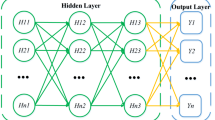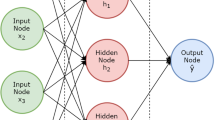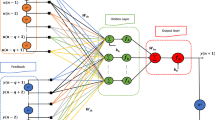Abstract
To improve the RMB exchange rate prediction and risk measurement, the RMB exchange rate prediction model is constructed based on deep learning approaches. Value at risk (VaR) risk measurement related data are used, and this model is combined with the autoregressive moving average model-generalized autoregressive conditional heteroskedasticity (ARMA-GARCH) model to fabricate an integrated VaR risk measurement model. The effectiveness of the proposed model is verified on specific example data. The results show that the proposed deep learning RMB exchange rate prediction model has better performance than traditional exchange rate prediction models in predicting exchange rates in different international foreign exchange markets, with accuracy of 74.92%. ARMA-GARCH risk prediction model has good measurement performance for the market, and its accuracy is significantly higher than that of the traditional measurement model. The deep confidence network model has stable performance and ideal forecasting effects both in the forecast of exchange rate fluctuations and in risk measurement. In short, this research can improve China’s research on exchange rate fluctuations and effectively strengthens the ability of forecasting and risk assessment of the foreign exchange market.






Similar content being viewed by others
References
Abdullah, S., Siddiqua, S., Siddiquee, M. S. H., & Hossain, N. (2017). Modeling and forecasting exchange rate volatility in Bangladesh using GARCH models: A comparison based on normal and Student’s t-error distribution. Financial Innovation, 3(1), 18–24.
Al-Shboul, M., & Alsharari, N. (2019). The dynamic behavior of evolving efficiency: Evidence from the UAE stock markets. The Quarterly Review of Economics and Finance, 73, 119–315.
Amiri, H., Najafi Nezhad, M., Sayyadi, M. (2020). Risk measurement in value at risk (VaR): Application of levy GARCH models (Study of chemical industries in Tehran stock exchange). Financial Knowledge of Securities Analysis, pp.114–121.
Baffour, A. A., Feng, J., & Taylor, E. K. (2019). A hybrid artificial neural network-GJR modeling approach to forecasting currency exchange rate volatility. Neurocomputing, 365, 285–301.
Bakar, N. A., & Rosbi, S. (2017). Autoregressive integrated moving average (ARIMA) model for forecasting cryptocurrency exchange rate in high volatility environment: A new insight of bitcoin transaction. International Journal of Advanced Engineering Research and Science, 4(11), 237311–237321.
Bhuvaneshwari, D., & Ramya, K. (2017). Cointegration and causality between stock prices and exchange rate: Empirical evidence from India. SDMIMD Journal of Management, 8(1), 39–45.
Chen S, Zhang B, Deng J. Research on Risk Measurement in Financial Market Based on GARCH-VaR and FHS¡ ª¡ ªAn Example of Chinese Bond Market Applied Economics and Finance, 2018, 5(4), pp. 102-116.
Chen, L., Du, Z., & Hu, Z. (2020). Impact of economic policy uncertainty on exchange rate volatility of China. Finance Research Letters, 32, 101266–101273.
Dinh, D. V. (2020). Impulse response of inflation to economic growth dynamics: VAR model analysis. The Journal of Asian Finance, Economics, and Business, 7(9), 219–228.
Duck, W. (2017). The Complex dynamics of trust and legitimacy: Understanding interactions between the police and poor black neighborhood residents. The ANNALS of the American Academy of Political and Social Science, 673(1), 132–149.
Gaur, A. S., Ma, X., & Ding, Z. (2018). Home country supportiveness/unfavorableness and outward foreign direct investment from China. Journal of International Business Studies, 49(3), 324–345.
Giannaros, T. M., Melas, D., & Ziomas, I. (2017). Performance evaluation of the weather research and forecasting (WRF) model for assessing wind resource in Greece. Renewable Energy, 102, 190–198.
Guo, X., Chan, R. H., Wong, W. K., & Zhu, L. (2019). Mean–variance, mean–VaR, and mean–CVaR models for portfolio selection with background risk. Risk Management, 21(2), 73–98.
Han, Y., Gong, P., & Zhou, X. (2016). Correlations and risk contagion between mixed assets and mixed-asset portfolio VaR measurements in a dynamic view: An application based on time varying copula models. Physica A: Statistical Mechanics and Its Applications, 444, 940–953.
Hou, J., Wang, C., & Liu, P. (2018). How to improve the competiveness of natural gas in China with energy internet and “the belt and road initiative.” International Journal of Energy Research, 42(15), 4562–4583.
Ji, Q., Bouri, E., Roubaud, D., & Shahzad, S. J. H. (2018). Risk spillover between energy and agricultural commodity markets: A dependence-switching CoVaR-copula model. Energy Economics, 75, 14–27.
Korobilis, D., Yilmaz, K. (2018). Measuring dynamic connectedness with large Bayesian VAR models. Available at SSRN 3099725, pp. 2591-2604.
Kramarz, F., Martin, J., & Mejean, I. (2020). Volatility in the small and in the large: The lack of diversification in international trade. Journal of International Economics, 122, 103276–103281.
Kwofie, C., & Ansah, R. K. (2018). A study of the effect of inflation and exchange rate on stock market returns in Ghana. International Journal of Mathematics and Mathematical Sciences, 2018, 253–259.
Lewis, R., McPartland, J., & Ranjan, R. (2017). Blockchain and financial market innovation. Economic Perspectives, 41(7), 1–17.
Lin, X. L., Li, H., Ruan, C. Y. (2019). Risk measurement of supply chain finance based on the VaR model. International Conference on Frontier Computing: Springer, pp. 1267–1275.
Luo, X., Lam, K. P., Chen, Y., & Hong, T. (2017). Performance evaluation of an agent-based occupancy simulation model. Building and Environment, 115, 42–53.
Mhalla, L., Hambuckers, J., Lambert, M. (2020). Extremal connectedness and systemic risk of hedge funds. Available at SSRN, pp.125–131.
Mitra, S. (2017). Efficient option risk measurement with reduced model risk. Insurance: Mathematics and Economics, 72, 163–174.
Ni, L., Li, Y., Wang, X., Zhang, J., Yu, J., & Qi, C. (2019). Forecasting of forex time series data based on deep learning. Procedia Computer Science, 147, 647–652.
Qian, Z., Gan, J., Tu, Y., & Wang, F. (2019). International policy coordination and RMB internationalisation: Theory and historical experience. Economic and Political Studies, 7(1), 87–105.
Qiu, X., Ren, Y., Suganthan, P. N., & Amaratunga, G. A. (2017). Empirical mode decomposition-based ensemble deep learning for load demand time series forecasting. Applied Soft Computing, 54, 246–255.
Rapoo, M. I., & Xaba, D. (2017). A comparative analysis of artificial neural network and autoregressive integrated moving average model on modeling and forecasting exchange rate. International Journal of Economics and Management Engineering, 11(11), 2669–2672.
Savalia, S., & Emamian, V. (2018). Cardiac arrhythmia classification by multi-layer perceptron and convolution neural networks. Bioengineering, 5(2), 35–41.
Shahrbabki, P. E., Hajimohammadi, B., Shoeibi, S., Elmi, M., Yousefzadeh, A., Conti, G. O., Ferrante, M., Amirahmadi, M., Fakhri, Y., & Khaneghah, A. M. (2018). Probabilistic non-carcinogenic and carcinogenic risk assessments (Monte Carlo simulation method) of the measured acrylamide content in Tah-dig using QuEChERS extraction and UHPLC-MS/MS. Food and Chemical Toxicology, 118, 361–370.
Sharma, C., & Pal, D. (2020). Exchange rate volatility and tourism demand in India: Unraveling the asymmetric relationship. Journal of Travel Research, 59(7), 1282–1297.
Shen, C.-W., Min, C., & Wang, C.-C. (2019). Analyzing the trend of O2O commerce by bilingual text mining on social media. Computers in Human Behavior, 101, 474–483. https://doi.org/10.1016/j.chb.2018.09.031
Siokis, F. M. (2017). Financial markets during highly anxious time: Multifractal fluctuations in asset returns. Fractals, 25(03), 1750032–1750039.
Soo, C. K. (2018). Quantifying sentiment with news media across local housing markets. The Review of Financial Studies, 31(10), 3689–3719.
Sugiharti, L., Esquivias, M. A., & Setyorani, B. (2020). The impact of exchange rate volatility on Indonesia’s top exports to the five main export markets. Heliyon, 6(1), e03141–e03149.
Wong, D. K. T. (2020). The forward-looking ability of the real exchange rate and its misalignment to forecast the economic performance and the stock market return. The World Economy, 43, 359–363.
Yang, L., Cai, X. J., & Hamori, S. (2017). Does the crude oil price influence the exchange rates of oil-importing and oil-exporting countries differently? A wavelet coherence analysis. International Review of Economics & Finance, 49, 536–547.
Yang, M. X., & Gao, Z. (2018). The empirical analysis of RMB-USD exchange rate forecasting based on ARMA model. Journal of Science of Teachers’ College and University, 4, 6–14.
Yu, M. (2019). Forecasting Bitcoin volatility: The role of leverage effect and uncertainty. Physica A: Statistical Mechanics and Its Applications, 533, 120707–120713.
Zhou, Z., Fu, Z., Jiang, Y., Zeng, X., & Lin, L. (2020b). Can economic policy uncertainty predict exchange rate volatility? New evidence from the GARCH-MIDAS model. Finance Research Letters, 34, 101258.
Zhou, Z., Fu, Z., Jiang, Y., Zeng, X., & Lin, L. (2020a). Can economic policy uncertainty predict exchange rate volatility? New evidence from the GARCH-MIDAS model. Finance Research Letters, 34, 101258–101263.
Funding
This research was funded by Chinese National Funding of Social Sciences, grant number 17BJY185.
Author information
Authors and Affiliations
Contributions
CL: writing—original draft preparation; formal analysis, data curation; Conceptualization, methodology; ZT: formal analysis, data curation; Conceptualization, methodology; YG: formal analysis, data curation; Conceptualization, methodology; RW: visualization, supervision; M.AH: visualization, supervision; YF: writing—review and editing, visualization, supervision. All authors have read and agreed to the published version of the manuscript.
Corresponding author
Ethics declarations
Conflict of interest
All Authors declare that they have no conflict of interest.
Human and Animal Rights
This article does not contain any studies with human participants or animals performed by any of the authors.
Informed Consent
Informed consent was obtained from all individual participants included in the study.
Additional information
Publisher's Note
Springer Nature remains neutral with regard to jurisdictional claims in published maps and institutional affiliations.
Rights and permissions
About this article
Cite this article
Lu, C., Teng, Z., Gao, Y. et al. Analysis of Early Warning of RMB Exchange Rate Fluctuation and Value at Risk Measurement Based on Deep Learning. Comput Econ 59, 1501–1524 (2022). https://doi.org/10.1007/s10614-021-10172-z
Accepted:
Published:
Issue Date:
DOI: https://doi.org/10.1007/s10614-021-10172-z




